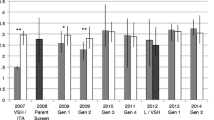Abstract
Two-way selection for lines of honey bees (Apis mellifera L.) susceptible and resistant to infestation by tracheal mites (Acarapis woodi Rennie) was conducted for two generations. Individuals of the susceptible line were 1.4 and 2.4 times more likely to become infested by female mites after the first and second generations, respectively. These results demonstrate that genotypic variability exsts within North American populations and that selection for resistance is feasible. The mechanisms of resistance are unknown.
Similar content being viewed by others
References
Bailey, L., 1958. The epidemiology of the infestation of the honey bee,Apis mellifera L., by the miteAcarapis woodi Rennie and the mortality of infested bees. Parasitology, 48:493–506.
Bailey, L., 1981. Honey Bee Pathology, Academic Press, New York, 124pp.
Delfinado-Baker, M., 1984.Acarapis woodi in the United States. Am. Bee J., 124:805–806
Gary, N.E. and Lorenzen, K., 1987 Vacuum device for collecting and dispensing honey bees (Hymenoptera: Apidae) into cages. Ann. Entomol. Soc. Am., 80:664–666.
Gary, N.E. and Page, R.E., 1987. Phenotypic variation in susceptibility of honey bees,Apis mellifera, to infestation by tracheal mites,Acarapis woodi. Exp. Appl. Acarol., 3:291–305.
Gary, N.E. Page, R.E., and Lorenzen, K., 1989 Effect of age of worker honey bees (Apis mellifera) on tracheal mite (Acarapis woodi) infestation. Exp. Appl. Acarol., 7:153–160.
Giordani, G., 1977. Facts about acarine mites. In: V. Harnaj (Editor), Proc. XXXVIth Int. Congress of Apiculture 13–19 October, Adelaide, Australia. Apimondia, Bucharest, pp. 459–467.
Laidlaw, H.H., 1977. Instrumental Insemination of Honey Bee Queens. Dadant & Sons. Hamilton, IL, 114 pp.
Lorenzen, K. and Gary, N.E., 1986. Modified dissection technique for diagnosis of tracheal mites (Acari: Tarsonemidae) in honey bees (Hymenoptera: Apidae). J. Econ. Entomol., 79:1401–1403.
Morgenthaler, O., 1929. Problems of Acarine disease of bees. Bee World, 10:19–24.
Morgenthaler, O., 1930. New investigations on Acarine disease. Bee World, 11:49–50.
Morgenthaler, O., 1931. An Acarine disease experimental apiary in the Bernese Lake District and some of the results obtained there. Bee World, 12:8–10.
Morgenthaler, O., 1932. Ein Jahrzehnt Milbenkrankheit der Honigbiene. Entdeckung, Erforschung und Bekampfung eines Seuchen-Erregers. Z. Angew. Entomol., 19:449–489.
Morrison, G.D., Jeffree, E.P., Murray, L. and Allen, M.D., 1956. Acarine andNosema diseases of honeybees in Britain, 1925–1947. Bull. Entomol. Res., 46: 753–759.
Robinson, F.A., Thel, K.L., Littell, R.C. and Linda, S.B., 1986. Sampling apiaries for honey bee tracheal mite (Acarapis woodi Rennie): Effects of bee age and colony infestation. Am. Bee J., 126: 193–195.
Sokal, R.R. and Rohlf, F.J., 1969. Biometry. Freeman, New York, 776 pp.
Author information
Authors and Affiliations
Rights and permissions
About this article
Cite this article
Page, R.E., Gary, N.E. Genotypic variation in susceptibility of honey bees (Apis mellifera) to infestation by tracheal mites (Acarapis woodi). Exp Appl Acarol 8, 275–283 (1990). https://doi.org/10.1007/BF01202137
Accepted:
Issue Date:
DOI: https://doi.org/10.1007/BF01202137




